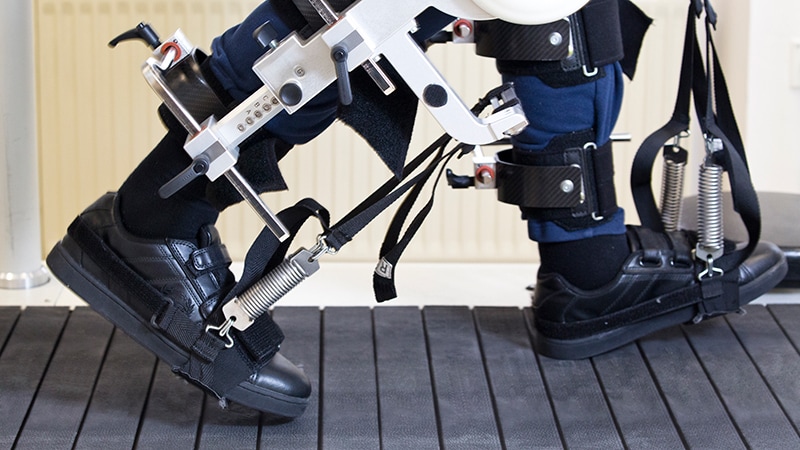
The study covered in this summary was published on ResearchSquare.com as a preprint and has not yet been peer reviewed.
Key Takeaways
-
Adding robotic-assisted gait training (RAGT) to a stroke rehabilitation program soon after the event maximizes the patient’s ability to walk independently.
-
Robotic gait devices allow the therapist and the patient to “work smarter, not harder” in regaining mobility.
-
Patients with greater impairment found the exoskeleton robotic device most natural to use; overall, patients felt comfortable with the device.
Why This Matters
-
Hemiplegia after stroke is common, and because many patients do not regain their former levels of independent mobility, gait rehabilitation is a major focus of treatment. Maximum therapeutic benefits are gained by high-intensity gait training in the first few weeks following a stroke, and adding RAGT to a regimen can help achieve this goal more easily.
-
RAGT can potentially make rehabilitation easier and more tolerable for patients and therapists alike.
Study Design
-
This study included 10 clinically stable individuals aged 18 years and older in an acute hospital setting (mean age, 64.5 ± 12.99 years; average days post stroke, 38.9). To use of the exoskeleton device (EKSO GT), participants had to be 1.58 – 1.88 m tall, with maximum hip width of 0.46 m and maximum weight of 100 kg.
-
Patients underwent anthropometric measurements and training in maximum assistance (MA) and adaptive assistance (AA) device modes and then completed questionnaires and recorded interviews after using the device.
-
Content analysis of qualitative interview data was performed, and summary statistics were used to describe and quantify patients’ impressions of the device.
Key Results
-
Participants rated walking in the device as being more comfortable in MA mode (mean Likert score, 8.4) than AA mode (mean Likert score, 7.6).
-
Overall, participants rated their gait as more natural in AA mode (mean Likert score, 7.3) than in MA mode (mean Likert score, 6.8).
-
Individuals with higher disability levels (measured by Modified Rankin Scale [MRS] for disability) rated walking in the device in MA mode as more natural, whereas those who were more independent in ambulation rated walking in MA mode as less natural. More physically independent participants rated the device as more comfortable when they could contribute to the movement, as evidenced by a moderate positive relationship between functional ambulatory category and comfort in AA mode and a corresponding negative relationship for MRS score.
-
Some participants found RAGT intimidating at first because of the device setup time, device weight, and, at times, their having difficulty following the therapist’s instructions. Their advice was to “keep an open mind, relax, and trust the device and therapists.” Patients were overall positive about RAGT and would use it if given the choice.
Limitations
-
The time required to record individual anthropometric measurements and to fit the device were limitations that may limit use of RAGT among stroke patients within a clinical facility.
Study Disclosures
-
The authors have disclosed no relevant financial relationships.
-
This study was supported by an EU H2020 MSCA RISE grant.
This is a summary of a preprint research study, “‘Go In With an Open Mind’: Perceptions of Exoskeleton Use During Gait Rehabilitation in an Acute Hospital Setting Following Stroke,” by Caitlin McDonald from University College Dublin, Ireland, and colleagues on Research Square, provided to you by Medscape. This study has not yet been peer reviewed. The full text of the study can be found on ResearchSquare.com.
For more news, follow Medscape on Facebook, Twitter, Instagram, and YouTube.
Source: Read Full Article